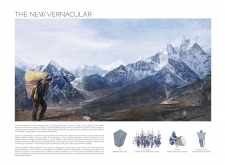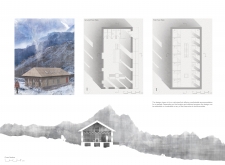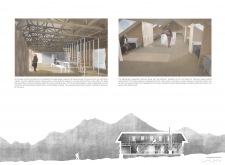5 key facts about this project
### Overview
Located in a mountainous area of the Himalayan region, "The New Vernacular" is an architectural response that integrates traditional building techniques with contemporary socio-economic and cultural considerations. The intent is to establish a multi-functional space that fosters community engagement and sustainable practices while adapting to the unique environmental conditions of its locale. The design emphasizes local resources and cultural context, aiming for a robust and functional structure that meets both ecological and social needs.
### Material Utilization and Structural Adaptability
The project employs a modular building system inspired by local practices and materials, prioritizing bamboo, stone, and wood for their unique properties. Bamboo serves as the primary structural component due to its lightweight and durable characteristics, echoing traditional construction methods. Stone is integrated to provide thermal mass, enhancing the building's resilience and stability, while wood is used in framing to add warmth to interior spaces. Each module, referred to as "Doko", features a cross-braced configuration that allows for rapid on-site assembly and ease of transport, an essential feature given the logistical challenges of the remote location.
### Spatial Strategy and Community Engagement
The spatial arrangement promotes both public and private activities, with communal areas such as a kitchen and dining area on the ground floor designed to facilitate social interaction. The first floor accommodates sleeping quarters, ensuring functional separation of spaces. Careful consideration is given to building orientation and window placements to optimize natural light and thermal performance, thereby minimizing energy consumption. The project highlights cultural integration by incorporating community involvement in both material sourcing and construction, strengthening local craftsmanship and supporting regional economies. The adaptable layout enables the building to evolve according to community needs, allowing for future growth and transformation.






















































